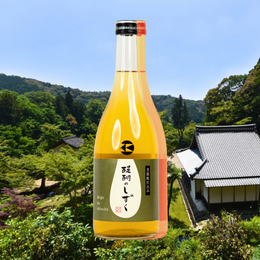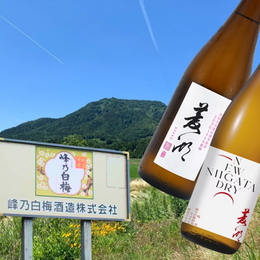
Shichiken is a 300 year old Sake brewer that is at the forefront of quiet revolution, leading the pack in the pursuit of the creation of an entirely new Sake category called AwaSake, or Sparkling Sake, with "Awa" taken to mean "foam".
In the land of over 1,000 breweries working the Junmai's and Daiginjo's, there are just 30 odd breweries officially producing AwaSake.


Watch for the small bubbles as a sign of quality.
Whilst the concept of a Sparkling Sake might initially seem simple enough - we're tempted to draw comparisons to Champagne-making - it actually comes with some very unique Sake specific challenges. For a true AwaSake to be made, external carbonation cannot be used, and thus the bubbles (in Japan they call it puchi puchi) have to develop naturally from fermentation alone. Yet unlike Champagne-making where a dose is used, with just a small spoonful of sugar and yeast is added to the wine to trigger a secondary fermentation that is what creates the fizz, Sake-makers are not allowed to add sugar to their Sakes, and thus this method is not a viable one.
AwaSake makers have thus found innovative solutions. One method is to brew two batches of Sake, where one is fermented and pasteurised as is done traditionally, whilst the second batch is fermented but left unpasteurised and thus preserves the active yeast and glucose; the two batches are then blended and bottled so as to effectively trigger a secondary fermentation that creates the bubbles. A second method that has emerged is to simply chill the Sake to the point that fermentation slows to a halt, fill it into bottles and then allow fermentation to restart as the temperature is brought back up. Nevertheless Sake and Champagnes are materially different in terms of natural acidity and alcoholic concentration, which leaves AwaSake makers still having to engage in continuous experimentation to determine what works best.

Traditional disgorgement.
That said, thankfully at least one aspect remains fairly straightforward - the disgorgement. Like Champagne, AwaSake can be disgorged by freezing the neck of the bottle to solidify the lees, which can then be popped out, removed, and the bottle resealed and ready for enjoyment!
Today whilst the Japanese government has yet to officially recognise AwaSake, several prominent brewers, including the historic Shichiken (or Yamanashi Meijo, the brewery's name), have come together (in the form of the Japan Awasake Association) to set in place key quality and production standards that will pave the way for official designation.

So who is Shichiken?
As mentioned, Shichiken Sake is the brand of Sake produced by Yamanashi Meijo, a historic brewer based in Yamanashi, Japan's land of fruit and wine, and was established in 1750. According to the brewery's lore, its founder Ibei Kitahara was en route to Edo (today's Tokyo) when he had fell in love with the water of Hakushu. Hakushu (a UNESCO designated Biosphere that is famed for its natural forestry and biodiversity) has long been known for producing some of the best quality natural spring water, revered by Japan's ceremonial tea masters, and is of course today most associated with the Japanese whisky distillery of the same name, Suntory's Hakushu. Nevertheless in 1750, Kitahara would thus relocate from Nagano Prefecture, where his family had been brewing Sake for generations, and would instead set up his brewery in Daigahara in Koshu Kaido in Yamanashi.

Fanlights that gave the name Shichiken, to mean bamboo groves.
Along the way, the 5th-generation Kitahara had received a gift from the daimyo of the Takato Domain, a pair of fanlights to celebrate the completion of a new building for the brewery. The fanlight was crafted by Senshiro Tatekawa, a celebrated carpenter whose work adorns some of Japan's most iconic shrines. On the fanlights was the title "Seven Sages of the Bamboo Grove" or Chikurin no Shichiken, and thus the name "Shichiken" stuck.
The Kitahara family has since carried on from generation to generation for 13 successive generations, today helmed by brothers Ryogo and Tsushima Kitahara.

The Meiji Emperor's view of the brewery's inner gardens.
Yet the reality is that you don't go 13 generations over 300 years without something outstanding happening. And so in 1880, something of great consequence happened to the brewery - the Meiji Emperor had been on an imperial tour through Yamanashi, Mie and Kyoto, and needed a place to stay for the night. It was thus chosen for the Emperor to spend the night in the inner chambers of the Shichiken brewery. In gratitude, the Emperor would gift the Kitahara family two rolls of white silk (called Habutai) and 50 year (not adjusted for inflation of course). This was a moment so crucial to the Kitahara family that since that very day, they had elected to never set foot in the room, considering it to be sacred - that was until it was designated as a national historical landmark that would be open to the public for viewing. As the Emperor's chambers had spanned most of the living spaces, the family would go the next 7 generations living in a much more confined room that was whatever was left spare that was not used by the Emperor that night.

13th-generation Tsushima and Ryogo Kitahara.
Another pivotal moment for the brewery came when the decision was made in 2014 to break with the traditional Toji system which dictates the brewery owner and master brewer come from separate families. With 13th-generation Ryogo Kitahara's appointment as Master Brewer, this has set an entirely new tone for Shichiken.
It's worth noting that for the better part of its history, Shichiken, like most Sake brewers stuck to the conventional styles of Sake, and it wasn't until the 13th-generation Kitahara brothers had visited the wine institute in their own Yamanashi Prefecture where they were able to better research how sparkling wines were made, that Shichiken too was able to produce a pioneering AwaSake in 2015. The Kitahara brothers had spent 5 years studying how CO2 gases are formed during the secondary fermentation, which they then took to experiment at the brewery where they had to figure out the precise gas pressures, alcohol levels and sweetness that would work well. A key tip - Kitahara points out to carefully observe the size of the bubbles of the Sparkling Sake, with small bubbles an indication of true secondary fermentation. Big bubbles are a sign of artificial or external carbonation.

Using local rice varieties (such as Hitogokochi and Asahinoyum) that the brewery grows in partnership with the local government and farmers in Hokuto, the rice grains are polished to between 50-70% rice polishing ratio to preserve sweetness needed for the special fermentation. From there only waters from Hakushu are used for the making of Shichiken's Sakes. The goal of which is to deliver a true distinct taste of Hakushu, which necessitates keeping all raw ingredients locally produced. Ryogo Kitahara thus emphasises the brewery’s duty to produce “sake that embodies Hakushu water.”

As a pioneer of AwaSake or Sparkling Sake, Shichiken has produced several expressions, some of which even includes maturation in Suntory Hakushu whisky barrels to add another layer of local flavours, and even boasts a collaboration Sparkling Sake with renowned French chef Alain Ducasse.

Today Shichiken has made itself a destination of choice, with an expanded offering at its brewery. Beyond just the brewery itself (which is open for visitors to even see first hand how the Sakes are made, which is otherwise typically kept a closely guarded secret by most other breweries), there's also a restaurant which serves seasonal cuisine paired with Shichiken's Sakes, focusing especially on local produce. At the restaurant you can even enjoy Hakushu water that's used for the Sakes as table water, and various parts of the Sake-making are also incorporated into the dishes, such as sauces made of sake kasu (lees). There's also a cafe where you can try Koji smoothies, and again local fruits such as Yamanashi peaches and blueberries, as well as a museum which chronicles 300 years of Sake making at Shichiken, and you'll also get to see the rooms stayed in by the Meiji Emperor!
And so with all that said, let's get down to trying Shichiken's pioneering Sparkling AwaSake!
Sake Review: Shichiken Starlight Hoshi no Kagayaki Sparkling Sake | 七賢スパークリング 星ノ輝
This is Shichiken's Starlight Sparkling Sake, also known as Hoshi no Kagayaki in Japanese, as it is named after the famously starry night sky over Hakushu. It's a Daiginjo made with 67% polished local Hitogokochi rice. This was made using the secondary fermentation technique in bottle.

Tasting Notes
Colour: Clear, Foamy Mousse
Aroma: It opens with a light soft and sweet breadiness and doughiness, with a little bit of that yeasty quality. Really bright and light ascents of orchard fruits of apples and pears, some zestiness of lemons too. It has a pure and raw quality to it, rich yet yeasty, with a more subtle base of still Sake.
Taste: Here the carbonation is gentle, soft and lush, woven into that richer body. It's lightly sweet with sweet rice mash notes, almost like a nigori. It has a good depth to it. Light touches of lemon meringue, also alittle bit of green pears, really cohesive with the overall body. More doughiness that leads into a light sourness.
Finish: More of that doughiness that persists, with some residual sweetness that's almost candied. Some white peach juice as well, all seamlessly leading into a clean and crisp finish. The finish here is nevertheless really gentle and plush, even as it's really firm and resolute with quite a noticeable fizziness.

My Thoughts
Well colour me surprised that this ain't Champagne! I actually liked this a whole bunch!
For starters, texturally and even to some extent aromatically, it really comes through in such close resemblance to Champagne. Yet where it differs is that here you have this more delicate and supple quality that holds within it that gentle sweetness of rice mash, much as you'd find in a nigori Sake (a lightly filtered cloudy Sake that leaves in much of the rice mash). It's the sort of sweetness you'd find at the core of rice porridge, and it works beautifully here with the light and uber lush bubbles. It also delivers a different take in terms of fruitiness, where here it's brighter and lighter, with also more of a peachiness, as you'd find in a Daiginjo sake. This is all in place of Champagne (or Prosecco and Cava, and most other grape-based sparkling wines) where you'd typically get more of that honey, toasty biscuity and apple core qualities.
I really enjoyed this and I find this a very unique take on a sparkling style drink. If you're a fan of Nigori's or Daiginjo's, and sparkling wines, this is definitely something you ought to try. This trades up apple cores, honey and toasted biscuits for sweet rice mash and white peaches, with still touches of those orchard fruits.
Kanpai!

@111hotpot







